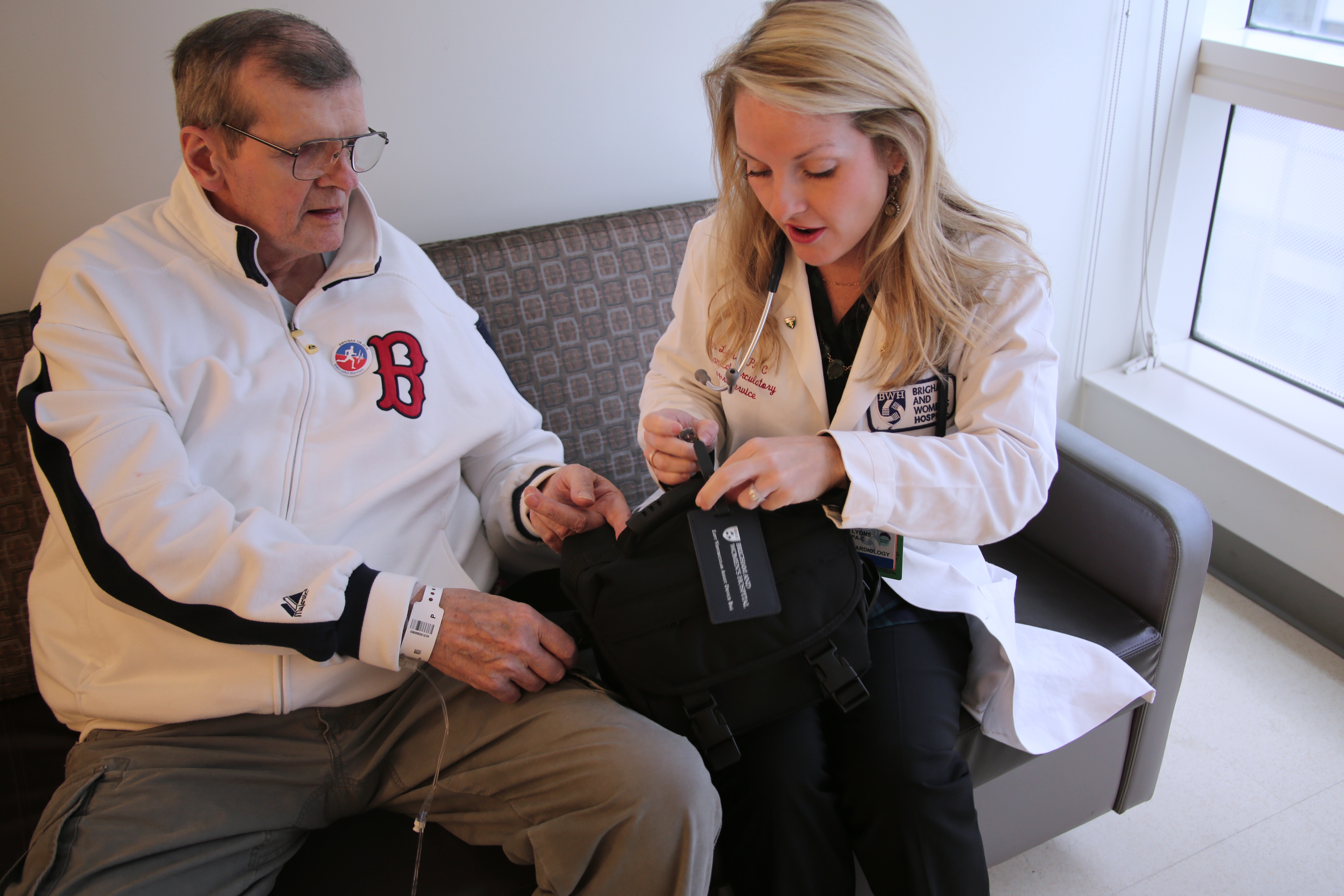Not Missing a Beat: Keeping LVAD Patients Safe at BWH and Beyond

Erin Lyons puts a personalized identification tag on BWH patient Thomas Ledbetter’s “VAD bag,” which contains backup equipment for his LVAD.
When Erin Lyons, PA-C, began working with patients who have a left ventricular assist device (LVAD) implanted as a result of heart failure, she was struck by their determination.
“Patients show so much resiliency and willpower to overcome the difficulties of living with LVADs,” she said. “They are truly remarkable.”
The device, a mechanical heart pump that supports heart function and blood flow in patients with heart failure, has both internal and external components. Straps positioned over the patient’s shoulders and across the back attach to external batteries that sit on the hips or waist. The batteries connect to a controller unit, which is also situated at the waist. A type of cable known as a driveline connects the controller to the LVAD pump inside the body.
While already wearing a considerable amount of gear, LVAD patients also must carry a backup controller and batteries in a “VAD bag” at all times. In the event of a malfunction with the device, patients, caregivers or emergency medical service (EMS) personnel need to change out the parts on the spot.
“It certainly adds to the challenges of living with an LVAD,” said Lyons, of the Division of Cardiovascular Medicine. “The bags must always be with the patient, regardless of where they travel.”
Inspired by their resolve, Lyons raised money to help out her LVAD patients. This June, she ran the B.A.A. 10K Road Race in Boston and used the opportunity to collect donations for her team, the BWH LVAD Warriors. By race day, she had raised roughly $2,800, nearly triple her initial $1,000 goal. While excited for her success, Lyons faced a new challenge – figuring out how to use the money.
A nurse colleague, Maryclare Hickey, RN, approached Lyons and the rest of the LVAD team with an opportunity. About the size of a camera bag, the VAD bags provided by BWH lacked any form of identification about the patient or even what it contained.
“Our patients are very in-tune with their own needs when it comes to treatment and care,” said Lyons. “They were including their own identification information with the bags because they knew that, should a medical emergency arise, EMS personnel would need to be aware of the VAD and its function.”
Spotting a gap they could fill, Lyons and her team created personalized luggage tags for the VAD bags. In addition to bearing the patient’s name, the tags also indicate which type of VAD the patient has and the emergency contact information for the VAD clinic at BWH. The tags can help EMS personnel provide appropriate care in a medical emergency, which is critical because lifesaving methods such as defibrillation need to be adapted for VAD patients.
The first recipient of the tags, Thomas Ledbetter, of Boston, said he deeply appreciated the VAD staff for their efforts.
“They’re such a phenomenal team,” he said. “These tags are so important. They may save my life one day.”
Ledbetter has known Lyons since his LVAD was implanted in November 2015. He spent five months recovering at BWH following his LVAD procedure due to complications, but the experience allowed Ledbetter to form a strong bond with Lyons and the rest of his care team.
“They’re like my family,” he said. “The support they give me is immeasurable. And I just hope I can give it back to them.”

Leave a Reply